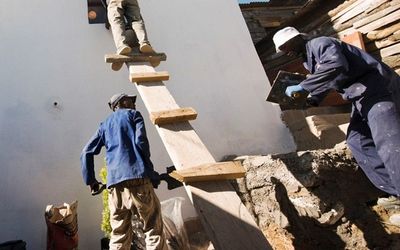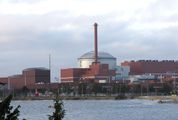HUMAN SETTLEMENTS: Past achievements are impressive but road ahead is daunting
by Greg Nicolson,
2014-11-20 07:01:33.0
ABOUT 3.2-million housing units have been completed or are being built for poor families, with nearly 1.5-million more to go.
Since its introduction in 1994 — with severe teething problems — the housing capital subsidy scheme has had a dramatic impact on what was then one of SA’s most pressing needs: housing for the poor. But the medium-term strategic framework’s (MTSF’s) objective of creating 1.49-million new housing opportunities by 2019 reflects the scale of the problem to be overcome. The MTSF says half will come from upgrading informal settlements, about 500,000 will come from the subsidy housing sub-market and 110,000 through loans.
The scheme, however, is being seen as a “blunt instrument” in light of the demand for housing and diverse needs. For example, the policy has created a “gap market” of households that earn too much to qualify for subsidised housing but do not have sufficient income to get a bond.
Both the NDP and MTSF recognise the greater need to leverage private sector funding to increase the supply of affordable housing in well-located areas and diverse communities.
Manie Annandale, head of Nedbank’s Affordable Housing Development Finance division, says the private sector’s role is to support the top affordable housing developers. “We do our funding very well and we want to stick to that,” he says. This year he expects Nedbank to disburse R1.3bn to finance affordable home developments, providing about 6,000 rental and freehold market housing opportunities.
Annandale says funders need to be flexible and work on feasible projects with reputable developers. “What the sector has done is sort of cottoned on to the integrated model,” he says of the latest trend. “Instead of government releasing a pocket of land solely for subsidy housing, like they had been doing for RDP homes, recently builders and the state have been developing areas that include subsidised homes but also houses for sale at R300,000 to R600,000, with properties for sale and rent.”
Mixing affordable options with subsidised housing means the municipality will have a higher rate base, developers can better afford land closer to transport and business nodes, and residents have multiple housing options within their area.
Currently, affordable housing supply falls far short of demand and it is widely acknowledged that the state will have to work closely with the private sector to bridge the gap. Essentially, government can assist developers by providing infrastructure such as water and sanitation to the area, which will reduce the cost of development.
The first step, however, is the state’s land release programme. “No development starts without land. That’s one commodity all developers are looking for,” says Annandale. “People can speak about demand until they’re blue in the face [but without land] people will have to rent or go to live in squatter camps.” He says Minister of Human Settlements Lindiwe Sisulu has been positive on releasing sufficient land to big projects, but not enough is being done yet.

Picture: ARC ECO HOMES
ABOUT 3.2-million housing units have been completed or are being built for poor families, with nearly 1.5-million more to go.
Since its introduction in 1994 — with severe teething problems — the housing capital subsidy scheme has had a dramatic impact on what was then one of SA’s most pressing needs: housing for the poor. But the medium-term strategic framework’s (MTSF’s) objective of creating 1.49-million new housing opportunities by 2019 reflects the scale of the problem to be overcome. The MTSF says half will come from upgrading informal settlements, about 500,000 will come from the subsidy housing sub-market and 110,000 through loans.
The scheme, however, is being seen as a “blunt instrument” in light of the demand for housing and diverse needs. For example, the policy has created a “gap market” of households that earn too much to qualify for subsidised housing but do not have sufficient income to get a bond.
Both the NDP and MTSF recognise the greater need to leverage private sector funding to increase the supply of affordable housing in well-located areas and diverse communities.
Manie Annandale, head of Nedbank’s Affordable Housing Development Finance division, says the private sector’s role is to support the top affordable housing developers. “We do our funding very well and we want to stick to that,” he says. This year he expects Nedbank to disburse R1.3bn to finance affordable home developments, providing about 6,000 rental and freehold market housing opportunities.
Annandale says funders need to be flexible and work on feasible projects with reputable developers. “What the sector has done is sort of cottoned on to the integrated model,” he says of the latest trend. “Instead of government releasing a pocket of land solely for subsidy housing, like they had been doing for RDP homes, recently builders and the state have been developing areas that include subsidised homes but also houses for sale at R300,000 to R600,000, with properties for sale and rent.”
Mixing affordable options with subsidised housing means the municipality will have a higher rate base, developers can better afford land closer to transport and business nodes, and residents have multiple housing options within their area.
Currently, affordable housing supply falls far short of demand and it is widely acknowledged that the state will have to work closely with the private sector to bridge the gap. Essentially, government can assist developers by providing infrastructure such as water and sanitation to the area, which will reduce the cost of development.
The first step, however, is the state’s land release programme. “No development starts without land. That’s one commodity all developers are looking for,” says Annandale. “People can speak about demand until they’re blue in the face [but without land] people will have to rent or go to live in squatter camps.” He says Minister of Human Settlements Lindiwe Sisulu has been positive on releasing sufficient land to big projects, but not enough is being done yet.




















Change: -0.47%
Change: -0.61%
Change: 0.53%
Change: -0.42%
Change: -2.12%
Data supplied by Profile Data
Change: -0.46%
Change: -0.19%
Change: -0.47%
Change: 0.00%
Change: -0.16%
Data supplied by Profile Data
Change: -1.11%
Change: -1.07%
Change: -0.63%
Change: -1.21%
Change: -1.24%
Data supplied by Profile Data
Change: 0.52%
Change: 1.25%
Change: 1.31%
Change: 0.18%
Change: 1.12%
Data supplied by Profile Data